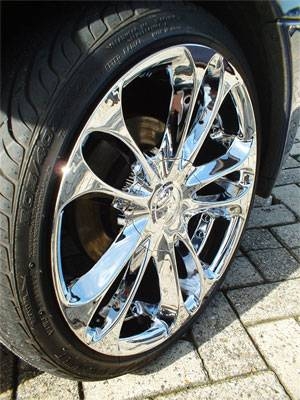
Rims are a standard structural element of a car's design, but these metal cylinders can also be a custom accessory that improves the car's appearance, traction and steering. Car enthusiasts of all kinds browse the huge aftermarket selection for rims that suit their vehicle and make a statement that's often as distinctive as the owners themselves.
Technically the rim is the outer perimeter of the wheel, a circular band of metal that holds the tire. Over time, however, wheels without hubcaps, particularly the custom wheels sold to enhance hot rods and low-riders, have come to be referred to as rims.
The size and style of rims affect not only the looks of the car, but also the ride and handling. Shiny chrome rims are flashy and get the car noticed. Larger diameter rims are used with low profile tires for improved handling. Choose lightweight alloy rims for easy maneuverability in city traffic.
Rims are measured by diameter, starting at 13 inches for small cars and going up to 30 inches for SUVs and trucks. Car owners often change standard size rims to larger diameter rims for a different look, or to provide better traction and handling. Drastically changing the rim size requires adaptations to the suspension to ensure the car handles correctly and operates safely. Rims are also available in varying widths, and must match the tire section width for proper, safe car function.
Standard wheel rims are made of steel, while custom rims are usually cast aluminum alloy or magnesium alloy. Magnesium tires ("mag wheels" or mags") are super lightweight rims used for racing. They are impractical for street driving and can be flammable after a blowout.
Rims come in a variety of sizes to fit every car, matching the standard size or altering it to change the appearance or handling. Rim finishes typically run in varying shades and sheens of gray, chrome and silver, but can also be white, black, blue, gold and other custom colors. Rims can have solid or spoked styles, with infinite design details that range from subtle grooves to interlaced spokes to carved figure silhouettes. Spinner rims attract a lot of attention as they rotate freely even after the car has stopped moving.
Choose the offset on the rims you buy. Front-wheel-drive offset means the center spider is flush or nearly flush with the exterior edge of the rim, while the spider is set further back for rear-wheel-drive offset. Be aware that offset is labeled rear or front wheel drive, but is not necessarily tied to the car's drive mechanism.
Not all rims will work with your car's design. Use print and online resources like the "Wheel Visualizer" from Custom Wheels and Car Rims' website to view different styles with your vehicle. Too large rims can cause your tires to rub against the fender or parts of the undercarriage, causing damage. Remember to check that you can turn the wheels fully without scraping along any part of the car. Some rims may not allow space for your brake system, so be sure you have a compatible style before you buy.
Remember that going larger or smaller than factory size rims will cause your odometer to register mileage incorrectly. Take your car to a reliable transmission shop or custom car experts to have the speedometer gear in the transmission altered to match your new rims.
Heat will cause tires to expand. If your new rims and tires have just enough clearance when it's cool out, replace with smaller rims to avoid inevitable rubbing and damage at warmer temperatures.
Rear-wheel-drive offset is necessary when selecting spinning rims. Spinners should ride inside the rim, not extend past the edge where it can get damaged or hit the body of the car on bumps and turns.